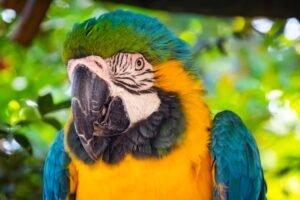A healthy and strong beak is essential for the parrot. It helps in carrying out important daily functions such as eating, preening, exploring, and more.
Beak problems and deformities can hinder a parrot’s ability to perform those functions and lead to issues like inability to eat, consequent weight loss, and overall poor quality of life.
Minor beak injuries don’t necessarily come in the way of eating, however, if the beak breaks off, it cannot be repaired without significantly impacting the parrot’s lifestyle.
In addition to injuries, the beak can also be affected by deformities, infections, and certain diseases.
This is why identifying beak problems early can help your parrot get treatment on time and prevent further complications.
Quick Navigation
What Does A Healthy Parrot Beak Look Like?
Before we talk about different parrot beak problems, we should know what exactly a healthy beak should look like. Your parrot’s beak should look smooth and even from both slides. It should not have any cracks or dull spots. Your parrot easily chomping through hard foods is also a good indicator that the beak is in good shape.

Beak Problems In Parrots
Parrots may face beak problems due to injuries, infections, or nutritional issues. Below are the 9 common beak problems in parrots:
Overgrown Beak
Parrots usually keep their beaks trimmed down using their excellent grooming abilities. They use wooden perches or any other hard surface to grind their beaks against and keep them in top shape. But sometimes, the beaks can grow too long and you might not notice it until it is obvious.
An overgrown beak is not a normal occurrence. It may suggest various health issues that need to be checked out by a vet. This condition can be the result of health conditions including trauma, genetic predispositions, nutritional deficiencies, or liver disease.
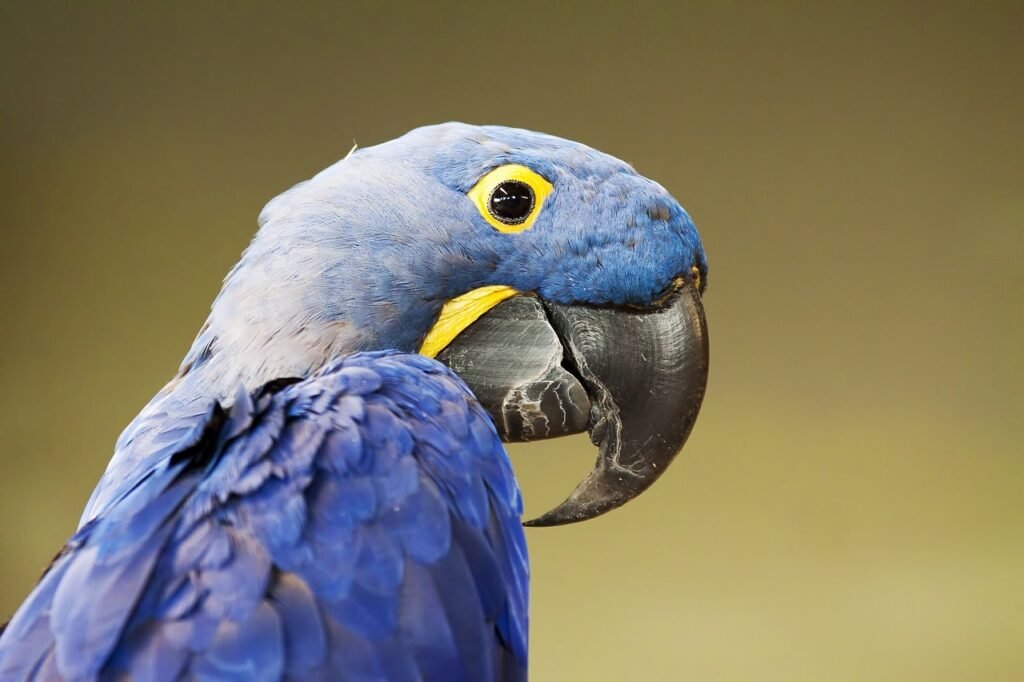
Scissor Beak
Scissor beak, also known as crossbeak is a condition where the upper and lower beaks do not align properly. Instead of meeting and closing in the middle, the two beaks overlap each other tilting to one side, creating a crossed or scissors-like appearance.
Scissor beaks can occur due to genetic mutations or improper weaning. Fortunately, it can be corrected by trimming the ends of the beak. It is important to get it filed early because scissor beaks can make it difficult for the parrot to eat leading to nutritional problems and weight loss. If the upper beak grows long enough, it may even hurt the parrot’s neck and restrict normal movement.
Prognathism Or “Parrot Beak”
Parrot beak is a condition where the lower beak extends farther than the upper beak. The lower beak protrudes further forward causing the tip of the beak to rest inside it.
Prognathism in parrots can occur due to developmental issues, or injuries to the beak. It can lead to difficulties in eating food, as well as potential challenges in preening and other beak-related behaviors.
The lower beak can be trimmed back down to solve the issue but it will grow back until the deformity is corrected. To correct the protrusion, surgical intervention might be required.

Soft Beak
The firmness of the beak can also tell you a lot about your parrot’s health. The soft and rubbery beak is often the result of poor nutrition. A parrot may develop a soft beak when it lacks vitamin D and calcium. It can be dangerous for the parrot as it makes it more prone to beak injuries.
This condition can be treated by putting the parrot on a proper diet that promotes healthy beak growth. As the new layers of keratin form, it will replace the softened beak with a strong outer shell.
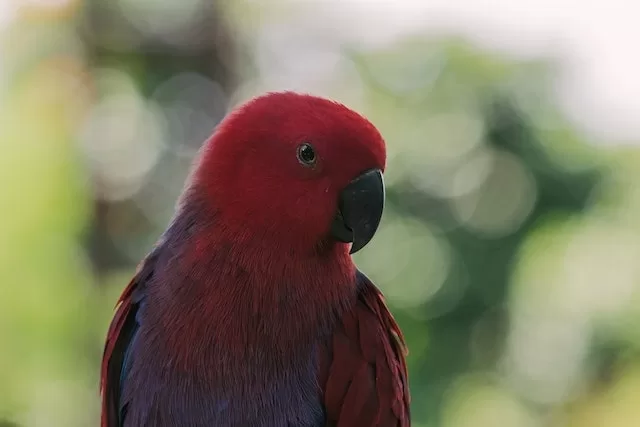
Cracked/Broken Beak
The rough condition of your parrot’s beak can tell you what it had been up to recently. Parrots like to play and explore their environment, flying swiftly from one spot to another, so occasional cracks and abrasions can be quite likely.
Most of the time, their sturdy beaks can take a lot of those hits and be unscathed, however, it is not unbreakable. Significant trauma to the beak can cause damage and even bleeding. The beak has nerve endings and several blood vessels, most of them being concentrated close to the. So when a parrot hurts its beak, it can be very painful and cause a lot of bleeding.
Small cracks can heal on their own as the beak grows out but broken beaks cannot be repaired. When letting your parrot out of its cage, try to keep an eye out for any kind of household item that may hurt them.
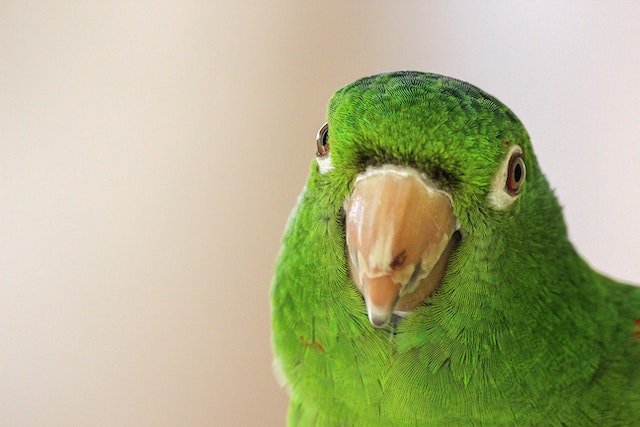
Beak Infections
Parasites and infections usually lurk in unhygienic environments. They can make their way into the parrot’s stomach through poor-quality food and water and cause a number of problems, including beak infections.
Psittacine Beak and Feather Disease (PBFD) is a condition that affects both captive and wild parrots. In many cases, the parrot may remain asymptomatic for years before displaying outward symptoms which increases the risk of the disease being spread to other parrots. Parrots with a weak immune system or deficiencies are at a higher risk of getting affected by PBFD.
Symptoms of PBFD:
- Depression.
- Lethargy.
- Anorexia.
- Vomiting.
- Weight loss.
- Diarrhea with mucus.
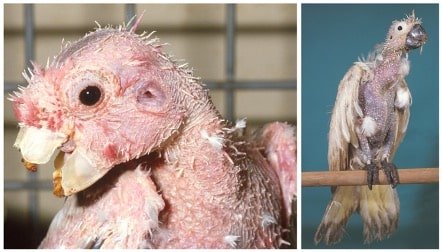
Scaly Face Mites
Parrot beaks can also be infested with mites, which can cause scales on the beak and skin. It is caused by microscopic mites medically referred to as Knemidokoptes. Symptoms of scaly mites infection include scaly and crusted skin on areas with no feathers like the bird’s face, beak, and legs.
In the early stages, the conditions may start with the skin, particularly the foot. The skin may look swollen and flaky. The beak may also start to develop scales and abnormal growth around the edges. To detect and treat mites infestation, proper diagnosis and tests are required.
However, this condition should not be confused with beak peeling or a flaky beak. It’s normal for parrots to have flaky beaks. The keratin layer on the parrot’s beak grows in layers so the outer layer is constantly being shed and replaced with new tissue.
It is also normal for the beak to appear flaky more often. It is rare to see a beak that is perfectly smooth. Sometimes parrots may rub their beaks too extreme to peel off the beak faster but it is important that you discourage them from doing that.
Beak Discoloration
Discoloration of the beak can have multiple causes including bruising, malnutrition, and diseases. If the colors appear to be rubbed off in a particular area, it is most like due to abrasion.
Sometimes, parrots develop dark spots or lose their natural colors slowly. This can be due to poor nutrition. Discoloration can be corrected by putting the parrot on a nutritious diet with foods high in carotenoids.
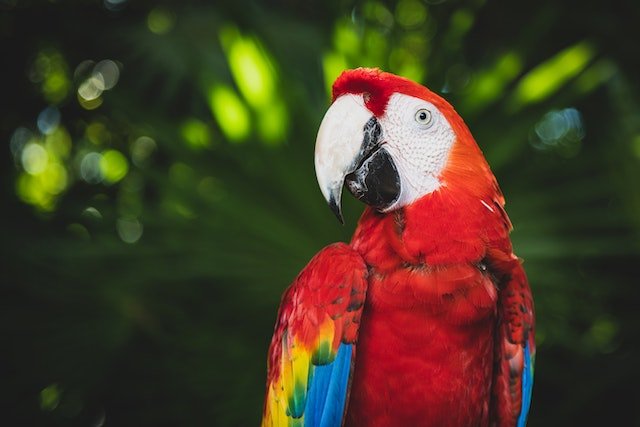
Cancer
Squamous cell carcinoma in birds is a type of skin cancer that mainly targets the outer layer of the skin, called the epidermis. Birds with this condition can develop cancerous tumors on the toes, wing tips, and around the eyes and the beak.
Squamous cell carcinoma is typically caused by overexposure to sunlight, so it usually affects birds that spend a lot of time outdoors. Parrots are at a much lower risk of developing this condition since they are kept as pets.
Prevention Of Beak Problems In Parrots
Beak problems in parrots can be prevented with proper care and attention to their nutritional needs. While it is difficult to prevent injuries, having precautionary measures can help to reduce the chances of an accident. Here are some essential tips for prevention:
Nutritious Diet
Since the hardened structure of the beak is made of keratin, a healthy and nutritious diet can greatly benefit their beak health.
You should ensure that the parrot gets adequate calories and enough of the vital nutrients from its diet.
An ideal diet for parrots is composed of high-quality pellets, lots of green and dark green vegetables, and some fruits.
However, if you want to correct your parrot’s diet to improve its beak condition, you should focus more on foods that are rich in calcium and Vitamin D.
These nutrients promote keratin production in the system and help in replacing the dead layer with new and strong beak tissue.
Some examples of food rich in vitamin D and calcium include eggs, oranges nuts, leafy vegetables, etc. Also, if beak coloration is an issue for your parrot, you should include more foods that are high in carotenoids such as carrots, spinach, broccoli, etc.
Wooden Perches And Toys
The wiping movement parrots do on different objects and surfaces is an instinctive action to file their beaks. In the wild, parrots have hard tree branches to rub their beaks on and keep them well-maintained.
You can simulate that environment by offering your parrot a wooden perch and toys that are made out of hardwood.
Parrot rub their beaks frequently on the ground and their perch, but if the surface isn’t right, the rubbing action would be ineffective.
In addition to wooden perches, you can also get them a cuttlebone. This will give them something to chew on and also act as a calcium supplement.
Regular Beak Check Up
It’s also equally important to have regular checkups of your parrot’s beak whether it’s at home or with the vet.
Healthy beaks are vibrant, strong, and symmetrical. It is also normal for a healthy beak to be a little flaky.
Parrot beaks do not undergo much change since the parrot is always keeping it in check. A parrot using its beak normally to climb cages, eat hard foods easily and play with its toys is a good indication that the beak is healthy.
However, if you notice an unusual change in your parrot’s beak or an abnormal growth surrounding it, you should take it to the vet for a checkup.
